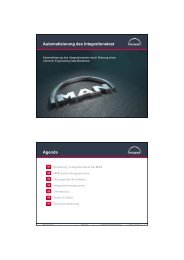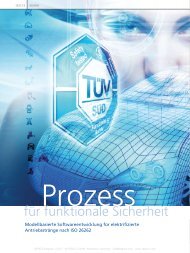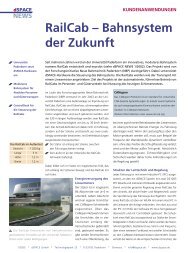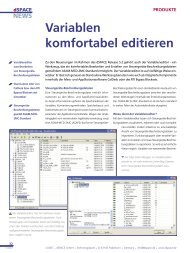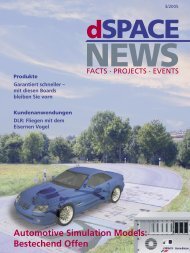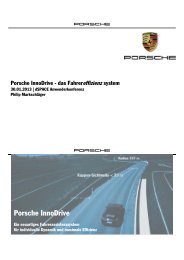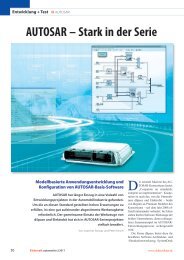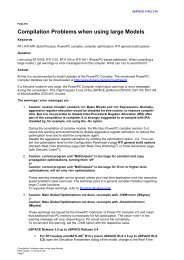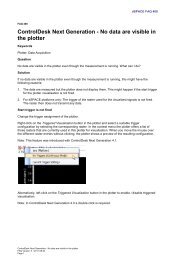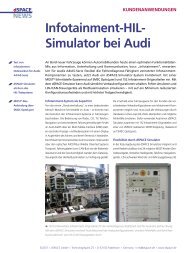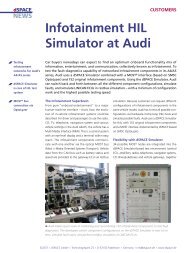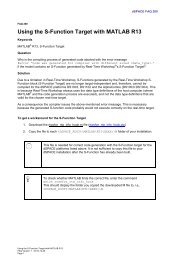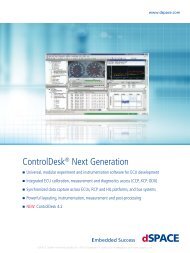magazinE - dSPACE
magazinE - dSPACE
magazinE - dSPACE
Create successful ePaper yourself
Turn your PDF publications into a flip-book with our unique Google optimized e-Paper software.
pAGe 40 ASM TRAFFIC<br />
Example Application<br />
The following example test case<br />
shows how the function of an<br />
ACC ECU is tested on a HIL<br />
simulator. First the scenario is<br />
defined, and then automated<br />
testing is performed. Finally,<br />
the example explains the results<br />
that are obtained. The objective<br />
of this example is to show<br />
how certain properties of an<br />
ACC system can be evaluated.<br />
Defining the Traffic Scenario<br />
The scenario comprises the test<br />
vehicle and three fellow vehicles,<br />
one of which cuts into the test<br />
vehicle’s lane. This lane change is<br />
triggered when the distance<br />
between the test vehicle and the<br />
fellow vehicle drops below a certain<br />
value. In addition to showing the<br />
basic definition options, this<br />
example scenario also explains the<br />
method of segmentbased definition<br />
and eventbased segment transition.<br />
Segment 1:<br />
The starting point is a maneuver in<br />
which the test vehicle T travels<br />
along the left lane of a straight road<br />
at a speed of 120 km/h. The first<br />
fellow vehicle is initialized at a<br />
distance of 200 meters ahead of the<br />
test vehicle. The longitudinal<br />
positions of the two other fellow<br />
vehicles are each defined in terms of<br />
the distance to the vehicle behind.<br />
All the fellow vehicles have a speed<br />
of 100 km/h.<br />
The test vehicle T approaches the<br />
fellow vehicles in the passing lane at<br />
the ACCregulated speed of<br />
120 km/h. When the distance<br />
between the test vehicle and fellow<br />
vehicle F2 drops below 30 meters,<br />
a segment end condition is reached.<br />
This event triggers the transition<br />
to the next segment, the cutin<br />
maneuver.<br />
Segment 2:<br />
Fellow vehicle F2 now performs a<br />
lane change into the passing lane<br />
(cut in). This brings it into the<br />
detection range of the test vehicle’s<br />
distance sensor. The ACC system<br />
now has to adjust the distance<br />
between the test vehicle and the<br />
fellow vehicle to the desired<br />
distance setting.<br />
Test Sequence<br />
Using the defined test scenario the<br />
following steps are performed at<br />
the HIL testing station to test the<br />
ACC ECU:<br />
1. The ACC is switched on and its<br />
settings are specified.<br />
2. The test scenario is run.<br />
3. Measurement begins with the<br />
fellow vehicle’s first steering<br />
action.<br />
4. Measurement data is captured<br />
until a constant driving state has<br />
been reached.<br />
5. The measured data is evaluated.<br />
To vary the simulation, steps 1 to 5<br />
can be repeated with the same scenarios<br />
but with different parameters.<br />
Variations<br />
Variations of the scenario can be<br />
run automatically in batch mode<br />
by using Python scripts in<br />
ModelDesk. The variations let the<br />
user apply different distance settings<br />
in the ACC and different fellow<br />
vehicle F2 speeds.<br />
measurement and Evaluation<br />
For evaluating this use case the<br />
following variables will be captured:<br />
n Speed of the test vehicle<br />
n Deceleration of the test vehicle<br />
n Speed of the fellow vehicle<br />
n Distance between the test vehicle<br />
and fellow vehicle F2<br />
Segment 1 (Initial)<br />
d<br />
s<br />
T<br />
Segment 1 (End)<br />
Segment 2<br />
d T = +2 m<br />
v T = 120 km/h<br />
s T = f (maneuver)<br />
F1<br />
T<br />
d F1 = -2 m<br />
v F1 = 100 km/h<br />
200 m



